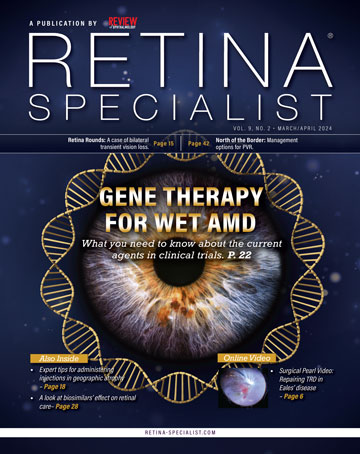Three clinical trials of biosimilars to Lucentis (ranibizumab) moving through the development pipeline have shown comparable safety and efficacy profiles to the index biological agent, investigators reported during the 34th annual meeting of the American Society of Retina Specialists (ASRS) last month.
India has been out in front with anti-VEGF biosimilars, with Intas Pharmaceuticals bringing the first, called Razumab, to market there last year. At ASRS, Srinivas Joshi, MD, of Hubli, India, reported on a trial of 119 eyes of 95 patients who received Razumab injections between November 2015 and May 2016. The patients had neovascular age-related macular degeneration, macular edema secondary to retinal vein occlusion or diabetic retinopathy. “No serious drug-related adverse events were identified,” Dr. Joshi said.
Central macular thickness improved from 345.9 ±128.84 μm at baseline to 287.65 ±90.29 μm after 30 days (p<0.0001), as did best-corrected visual acuity from 0.59 ±0.43 logMAR to 0.50 ±0.37 logMAR (p=0.0467), Dr. Joshi said.
“While the long-term safety and efficacy remain unknown, these short-term results suggest that Razumab could become a safe, low-cost therapy for macular diseases in developing countries,” Dr. Joshi said.
Another study from India showed similar results. Alay S. Banker, MD, from Ahmedabad, reported on a longer-term study of a Lucentis biosimilar with a mean follow-up of 13.3 weeks.
Ninety-four eyes of 69 patients received a total of 154 injections. Twenty-six eyes had choroidal neovascularization from AMD, 43 had diabetic macular edema, 13 had macular edema due to RVO and 12 had retinopathy of prematurity that warranted treatment. “All eyes had resolution of retinal edema with central subfield thickness reducing from a mean of 359.65 μm to 298.68 μm (p<0.01),” Dr. Banker said.
Additionally, mean logMAR visual acuity after injections improved from 0.53 to 0.37 (p<050).
None of the patients reported minor side effects like blurred vision, ocular pain, bulbar injection or intraocular inflammation, and none experienced any serious ocular or systemic effects, Dr. Banker said. “This new biosimilar ranibizumab could become a safe, low-cost therapy for retinal disease,” he said.
Pfenex, which is developing the biosimilar PF582, reported on the first in-human study of a Lucentis biosimilar in the United States. Hubert C. Chin, MD, chief medical officer, reported at the Ophthalmology Innovation Summit at ASRS that the Phase I/II trial involved 25 patients with wet AMD who had never had anti-VEGF treatment; 13 received PF582 and 12 Lucentis injections at three monthly intervals.
The trial reported no meaningful differences in intraocular pressure, systemic adverse events or safety or tolerability findings between the biosimilar and index agent.
Dr. Chin also noted that Pfenex had regained full rights to the agent after Pfizer turned them back. Pfizer acquired the rights when it acquired Hospira last year.
Could Organ Transplant Drug Be New Agent for Uveitis?
Intravitreal injections of the anti-rejection agent sirolimus may be a new treatment option to reduce vitreous haze in patients with noninfectious intermediate and posterior uveitis, according to results from the SAKURA Study 1 reported at ASRS.
Sirolimus inhibits mTOR—or mechanistic target of rapamycin—which regulates cellular metabolism and growth. The Phase III SAKURA Study 1 involved 347 subjects with baseline vitreous haze scores (VH) greater than 1, 118 of whom had a diagnosis of intermediate uveitis. They received three different doses of sirolimus—44 µg (active control), 440 µg or 880 µg—at days one, 60 and 120.
At five months, the proportion of the intermediate uveitis subjects who achieved the primary endpoint, VH 0, was 7 percent for 44 µg, 24.3 percent for 440 µg (p=0.056 vs. 44 µg) and 26.3 percent for 880 µg (p=0.031 vs. 44 µg). In the intermediate uveitis group, the secondary endpoint, VH of 0 or 0.5+, was achieved by 27.9 percent for 44 µg, 54.1 percent for 440 µg (p=0.023 vs. 44 µg) and 57.9 percent for 880 µg (p=0.008 vs. 44 µg).
The mean VH improvement at five months was -0.77 for 44 µg, -1.17 for 440 µg (p=0.02 vs. 44 µg) and -1.13 for 880 µg (p=0.037 vs. 44 µg). Response rates were higher in this subgroup than in the overall study population, said investigator Pauline T. Merrill, MD, of Illinois Retina Associates.
Sunil Srivastava, MD, of the Cleveland Clinic, also reported on 12-month results from SAKURA Study 1 of 347 subjects with noninfectious posterior uveitis on the same dosing regimens. At six months, subjects transitioned to an open-label treatment period during which they received injections of 880 µg every two months for the next four months.
At the end of open-label treatment (month 12), the proportion of subjects achieving VH 0 or 0.5+ was 42.1 percent overall (43.9 percent for 440/880 µg, 41.9 percent for 44/880 µg and 40.5 percent for 880/880 µg).
“The greatest visual benefit at month 12 was seen in subjects with worse best-corrected visual acuity at baseline,” Dr. Srivastava said.
The 440/880 µg group, patients with baseline BCVA <20/100 had a 9-ETDRS letter improvement vs. 5 letters for those with <20/40 BCVA and 1 letter in those with ≥20/40. Through 12 months, the most common ocular serious adverse events were inflammation (2.9 to 5.8 percent), cataract (3.8 percent) and medication residue (transient drug depot in the visual axis; 2.3 percent).



